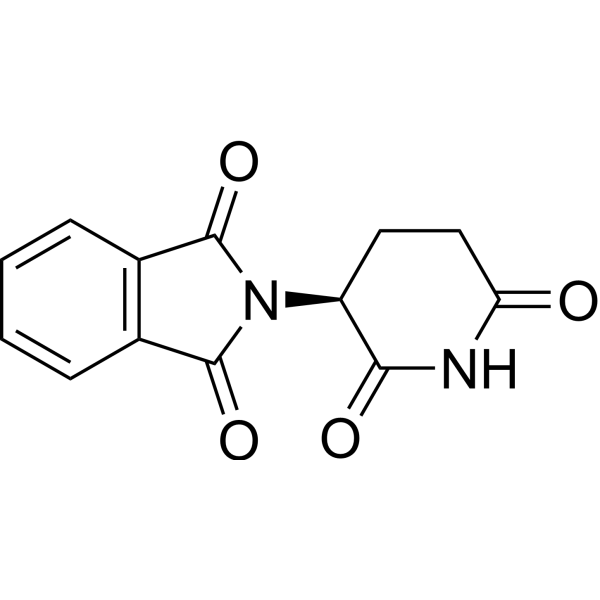| Cas No.: | 841-67-8 |
| Chemical Name: | 1H-Isoindole-1,3(2H)-dione,2-[(3S)-2,6-dioxo-3-piperidinyl]- |
| Synonyms: | 1H-Isoindole-1,3(2H)-dione,2-[(3S)-2,6-dioxo-3-piperidinyl]-;(S)-(-)-Thalidomide;(-)-(S)-1,3-dioxo-2-(2',6'-dioxopiperidin-3'-yl;(-)-N-[(S)-2,6-Dioxo-3-piperidinyl]phthalimide;(-)-THALIDOMIDE &N-[(S)-2,6-Dioxopiperidine-3-yl]phthalimide;(3S)-3-(1,3-Dioxo-2H-isoindole-2-yl)piperidine-2,6-dione;2-[(3S)-2,6-Dioxo-3-piperidyl]-1H-isoindole-1,3(2H)-dione;6-dioxo-3-piperidinyl)-3(2h)-dion(s)-1h-isoindole-2-(2;6-dioxo-3-piperidyl)-n-(l-(-)-phthalimid;L-thalidomide;S(-)-2-(2,6-DIOXO-3-PIPERIDINYL)-1H-ISOINDOLE-1,3(2H)-DIONE |
| SMILES: | O=C1NC(=O)[C@@H](N2C(=O)C3=C(C=CC=C3)C2=O)CC1 |
| Formula: | C13H10N2O4 |
| M.Wt: | 258.229503154755 |
| Purity: | >98% |
| Sotrage: | 2 years -20°C Powder, 2 weeks 4°C in DMSO, 6 months -80°C in DMSO |
| Description: | (S)-Thalidomide ((S)-(-)-Thalidomide) is the S-enantiomer of Thalidomide. (S)-Thalidomide has immunomodulatory, anti-inflammatory, antiangiogenic and pro-apoptotic effects[1][2][3]. (S)-Thalidomide induces teratogenic effects by binding to cereblon (CRBN) [4]. |
| Target: | Apoptosis[1] |
| In Vivo: | Thalidomide does cause limb reduction defects in chick embryos as long as the embryos are directly exposed to the drug. The most useful techniques are implanting Thalidomide-soaked beads into the embryo immediately adjacent to the limb territory or soaking presumptive chick limb territories in Thalidomide and then grafting the explants to a host embryo celom. Thalidomide affects the chick limb grafted to a host embryo in a dose response fashion. Furthermore, (S)-Thalidomide is more teratogenic than (R)-Thalidomide[1]. |
| In Vitro: | (S)-Thalidomide treatment results in a reduction in cell viability in U266 cells with an IC50 of 362 μM[1]. (S)-Thalidomide treatment increased apoptosis in a dose-dependent manner in U266 cells[1]. There are changes in the expression profile of genes involved in angiogenesis and apoptosis, but the changes are most dramatic in the apoptotic genes. In particular, the expression of I-κB kinase is decreased by two-fold, which is associated with a four-fold decrease in NF-κB expression. (S)-Thalidomide increases the Bax:Bcl-2 ratio, also increases I-kB protein levels, and decreases NF-kB activity. A dramatic decrease in Bcl-2 expression with (S)-Thalidomide suggests a possible enhancement of cytotoxic effect if combined with other cytotoxic agents[1]. Cell Viability Assay[1] Cell Line: U266 MM cells Concentration: 0 µM, 10 µM, 100 µM, 150 µM, 200 µM, 1000 µM Incubation Time: 3 days Result: A reduction in cell viability was observed in U266 cells. Apoptosis Analysis[1] Cell Line: U266 MM cells Concentration: 100 µM, 150 µM, 200 µM, 1000 µM Incubation Time: 3 days Result: Increased apoptosis in U266 cells. |
| References: | [1]. Liu WM, et al. s-thalidomide has a greater effect on apoptosis than angiogenesis in a multiple myeloma cell line. Hematol J. 2004;5(3):247-54. [2]. Stephens TD. The effect of thalidomide in chicken embryos. Birth Defects Res A Clin Mol Teratol. 2009 Aug;85(8):725-31. [3]. Murphy S, et al. Enantioselectivity of thalidomide serum and tissue concentrations in a rat glioma model and effects of combination treatment with cisplatin and BCNU. J Pharm Pharmacol. 2007 Jan;59(1):105-14. [4]. Tokunaga E, et al. Understanding the Thalidomide Chirality in Biological Processes by the Self-disproportionation of Enantiomers. Sci Rep. 2018 Nov 20;8(1):17131. |

 To enhance service speed and avoid tariff delays, we've opened a US warehouse. All US orders ship directly from our US facility.
To enhance service speed and avoid tariff delays, we've opened a US warehouse. All US orders ship directly from our US facility.




















